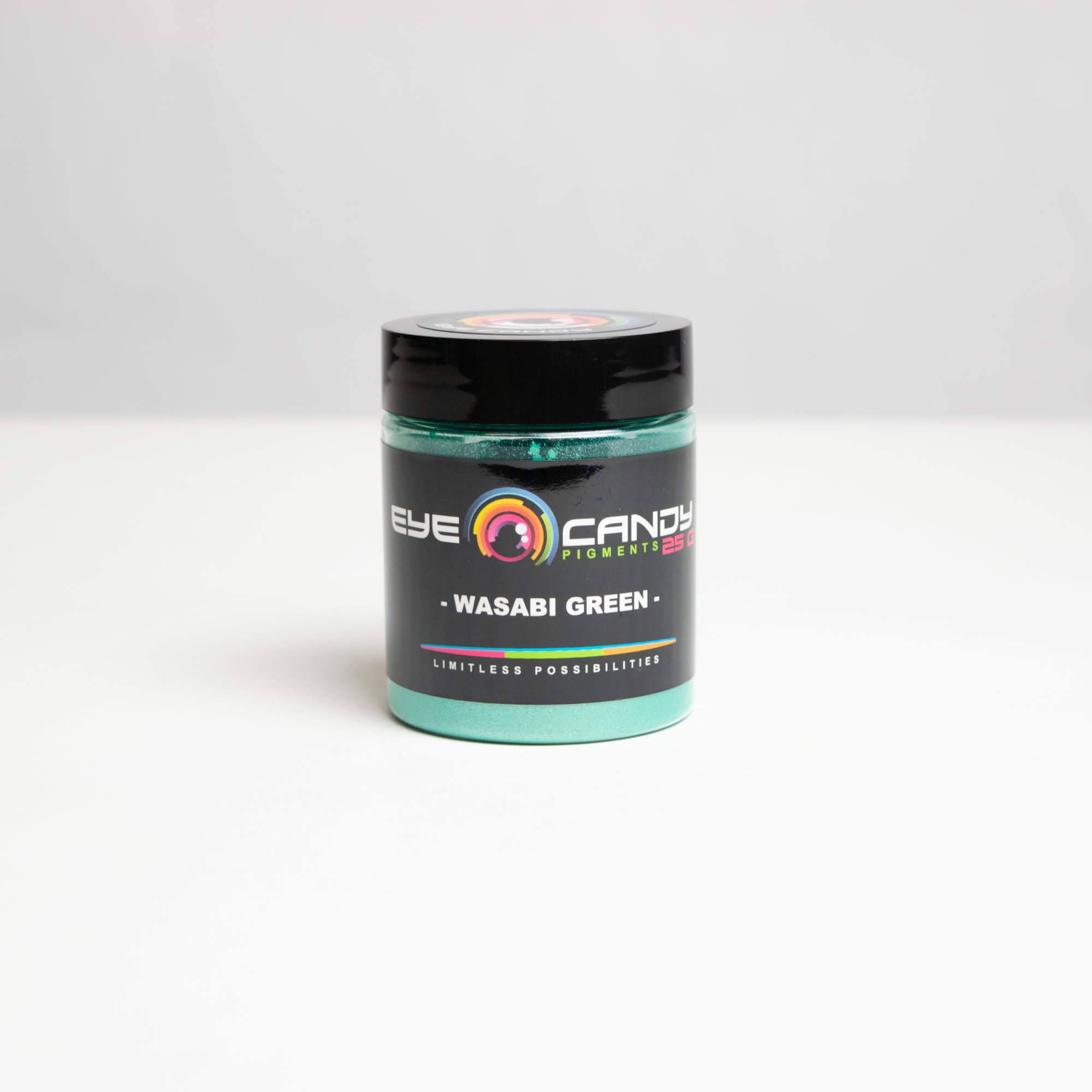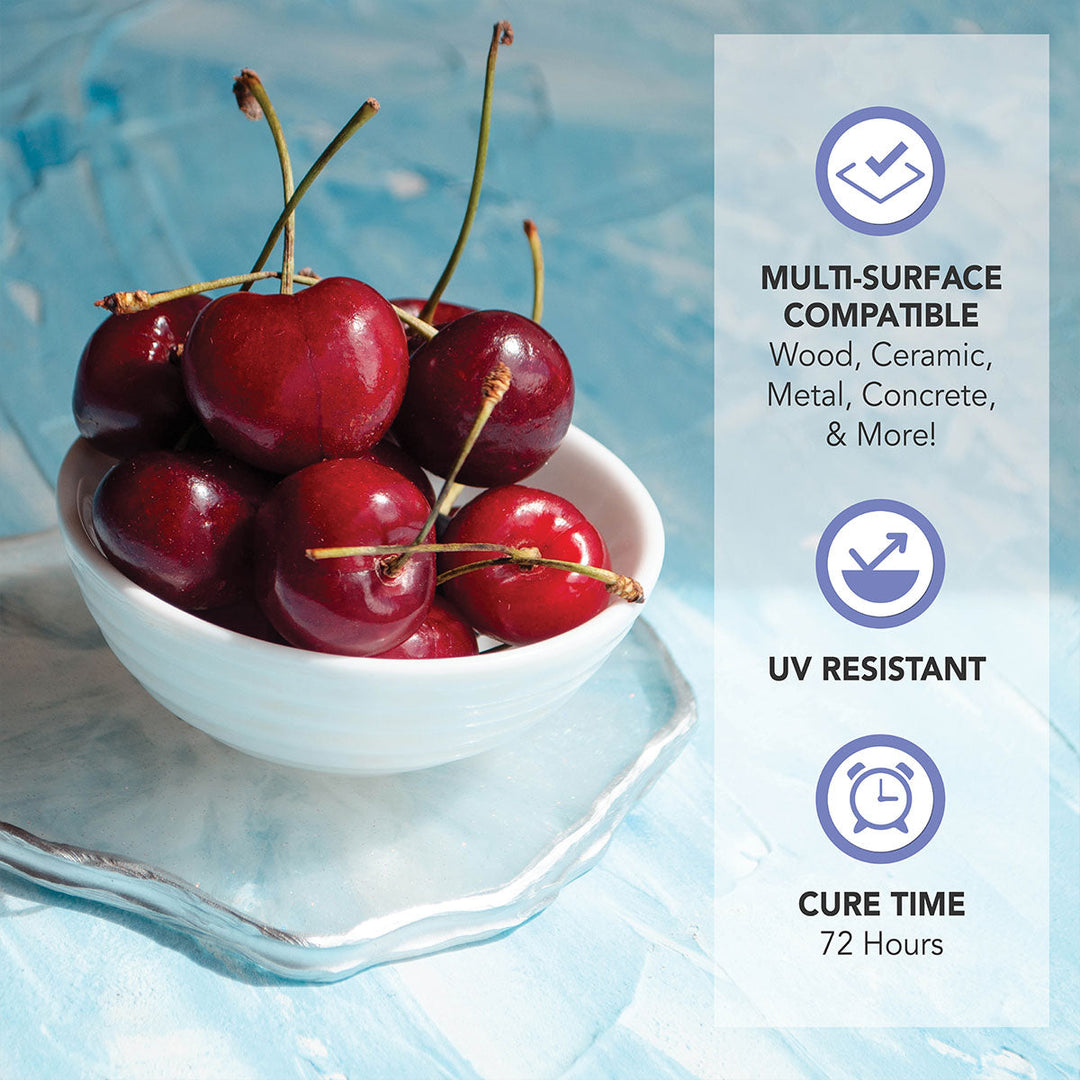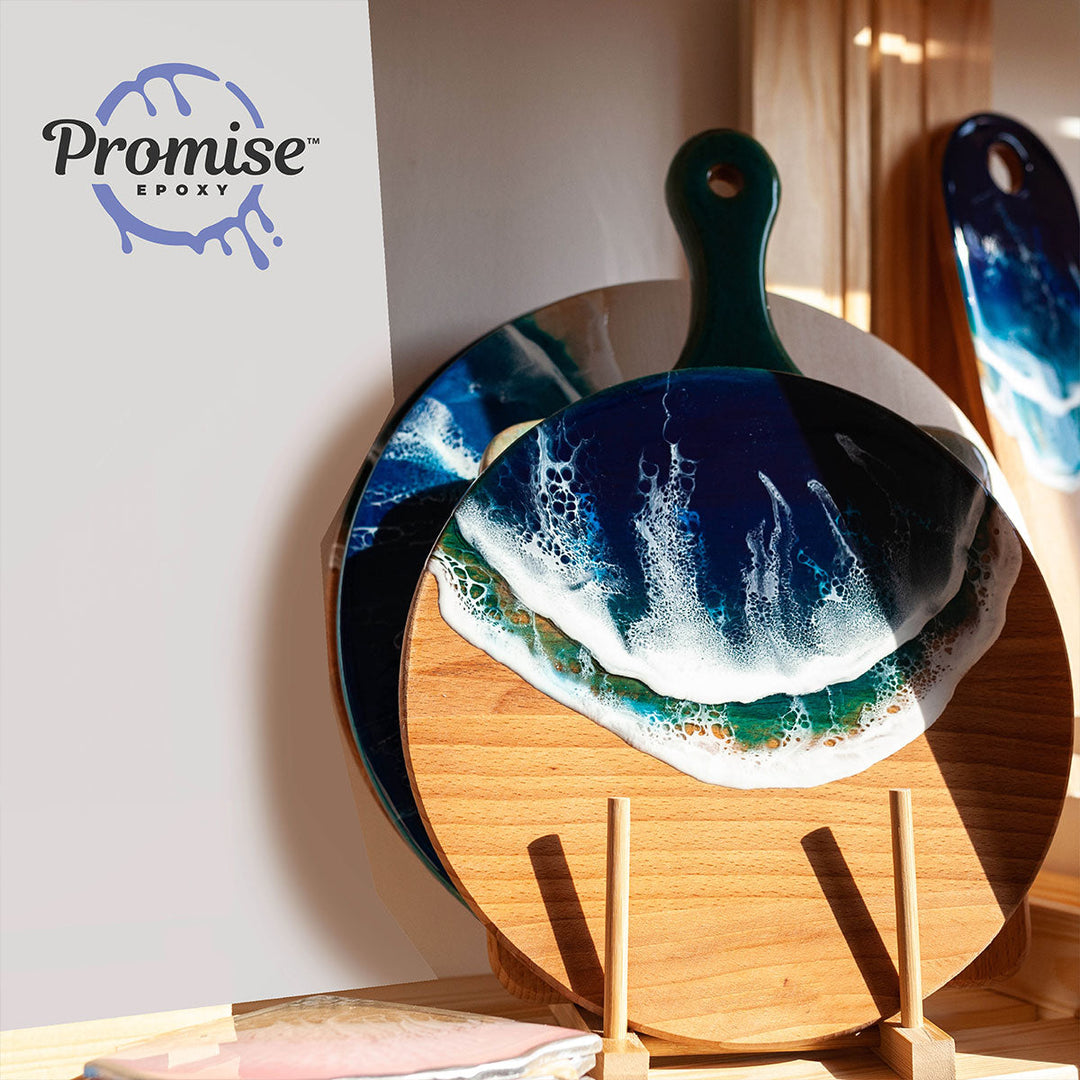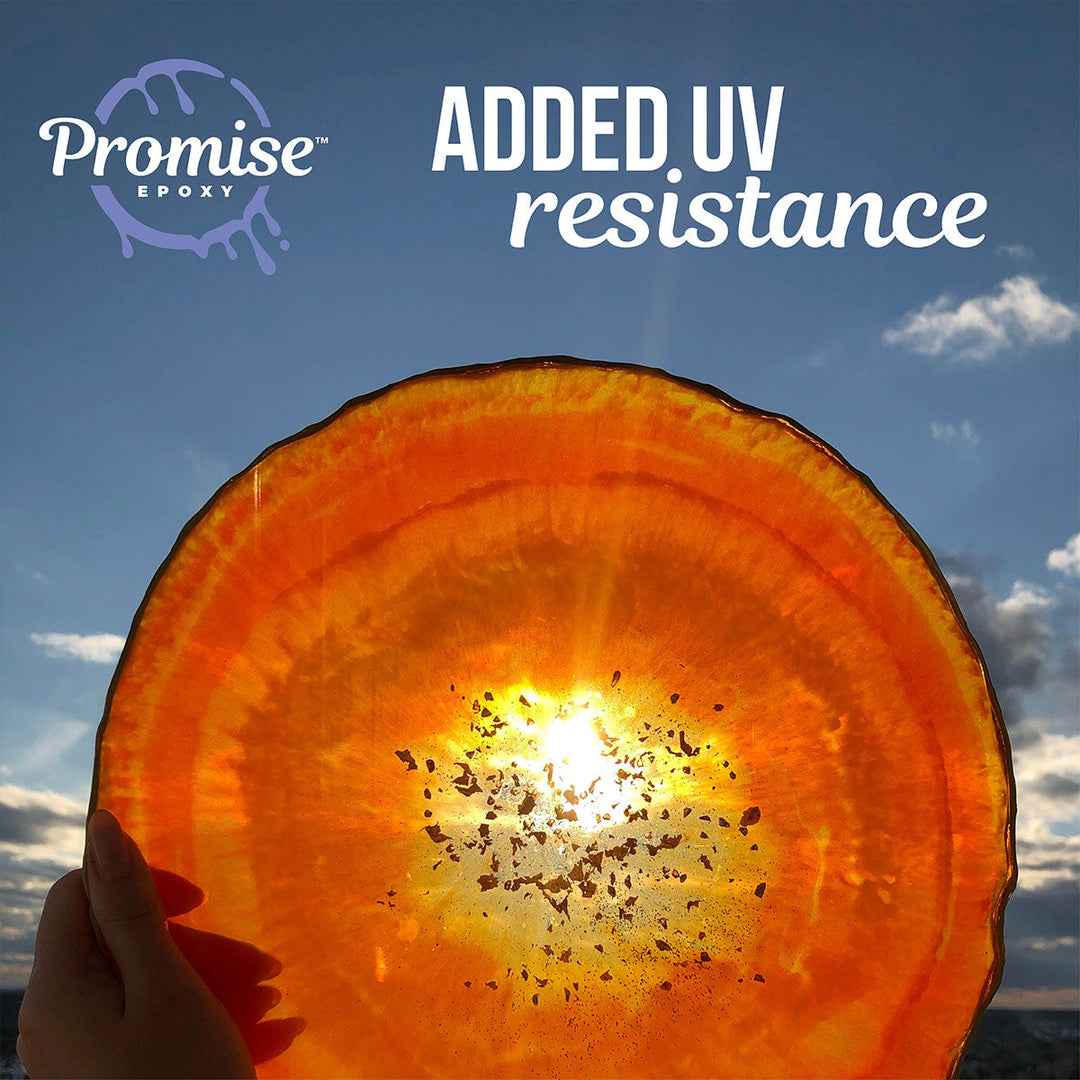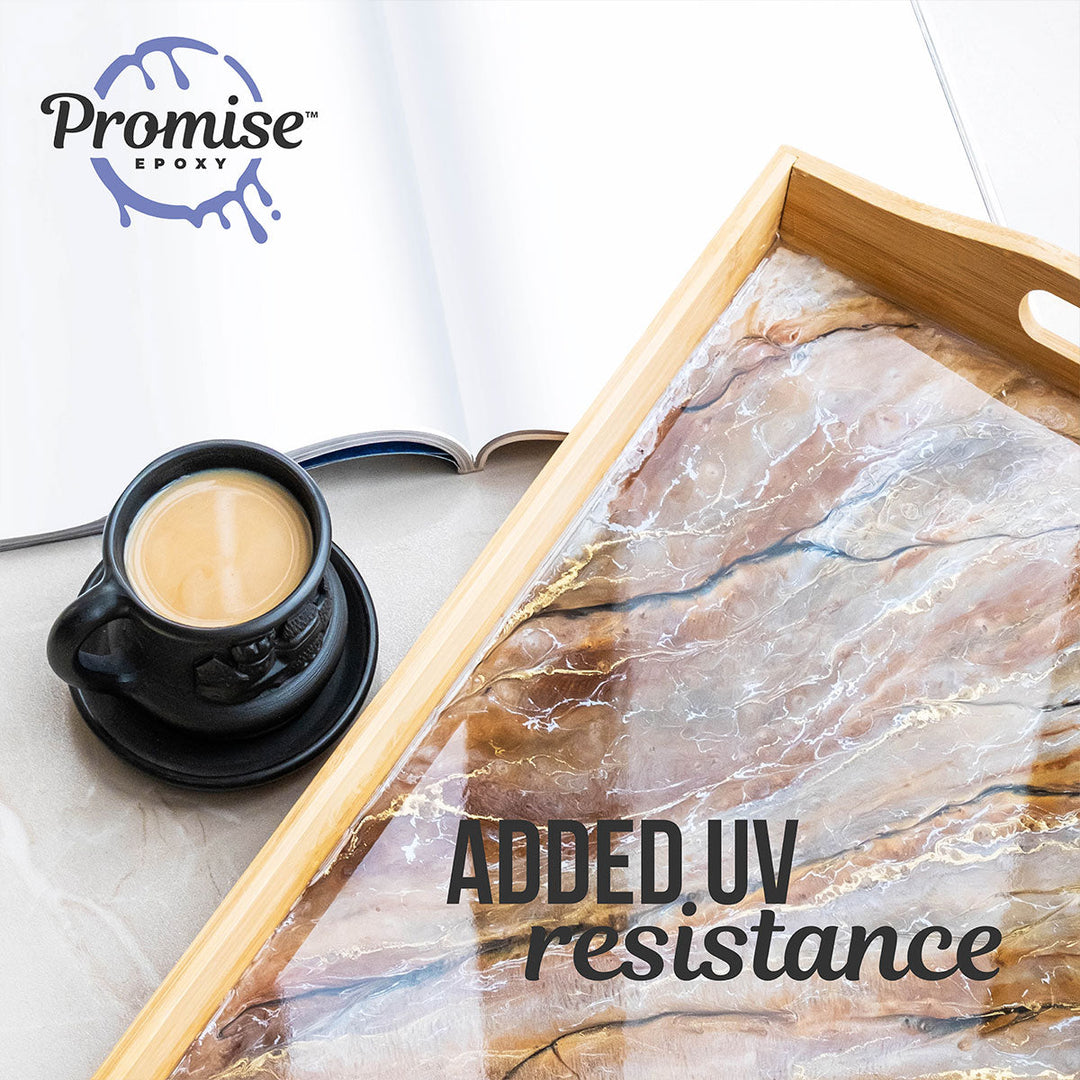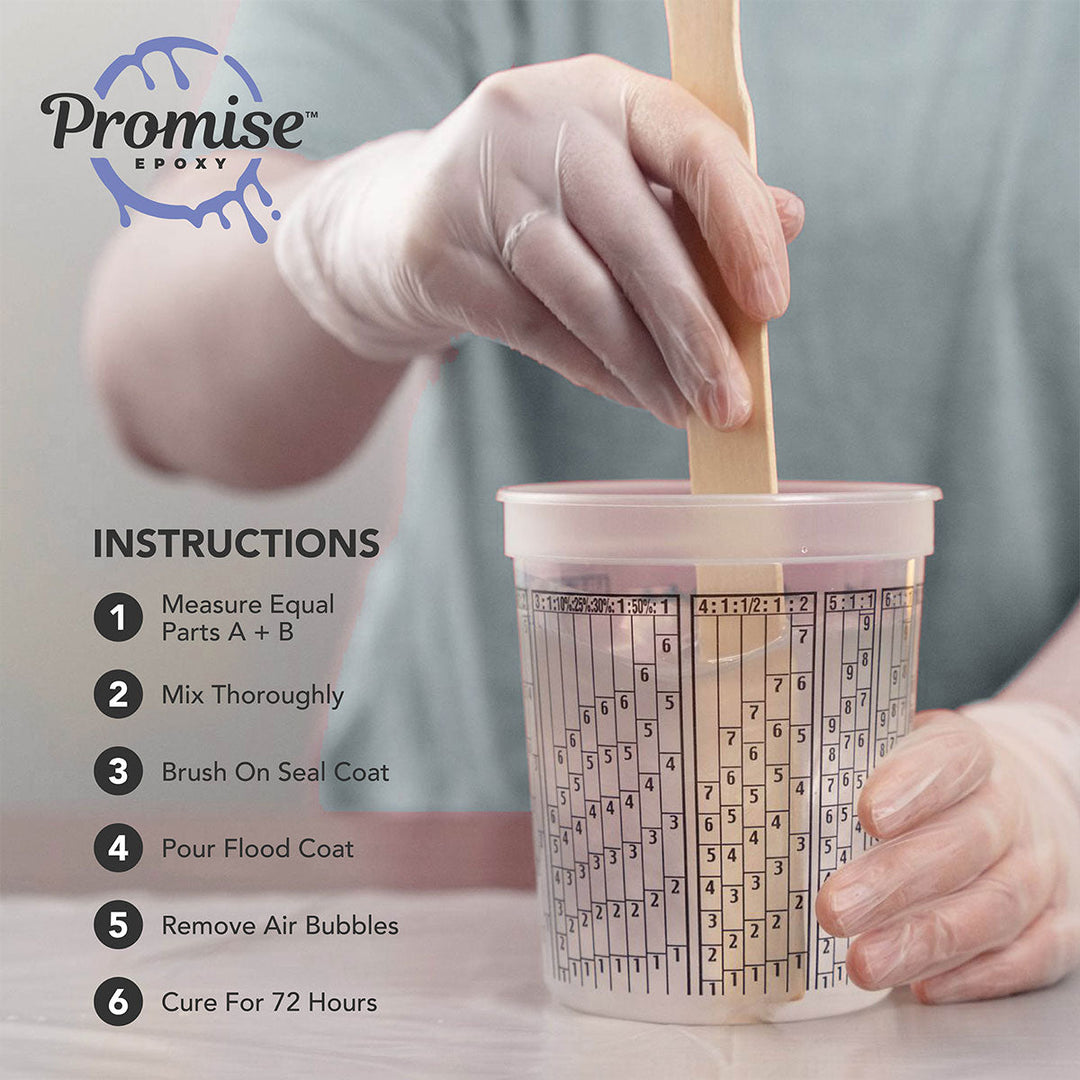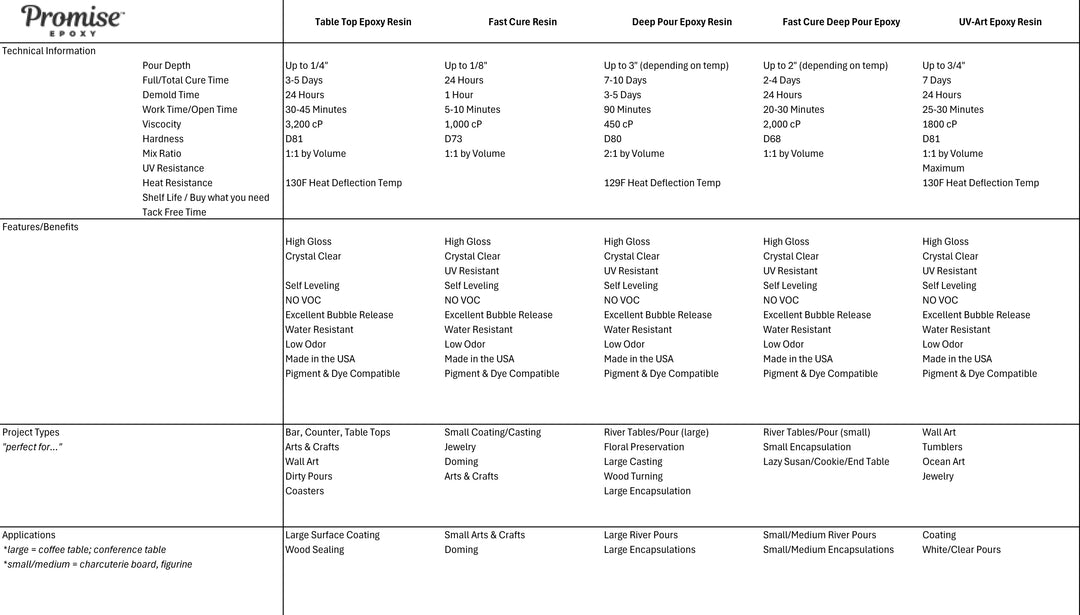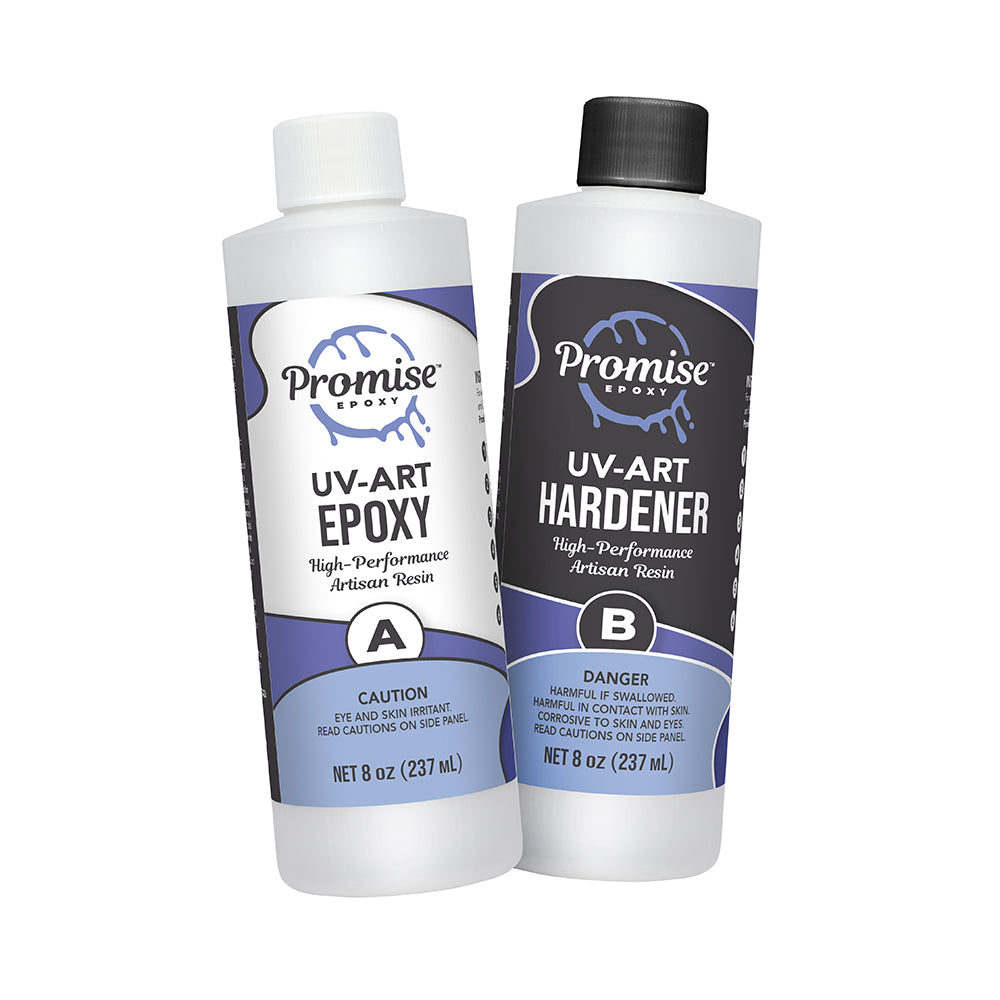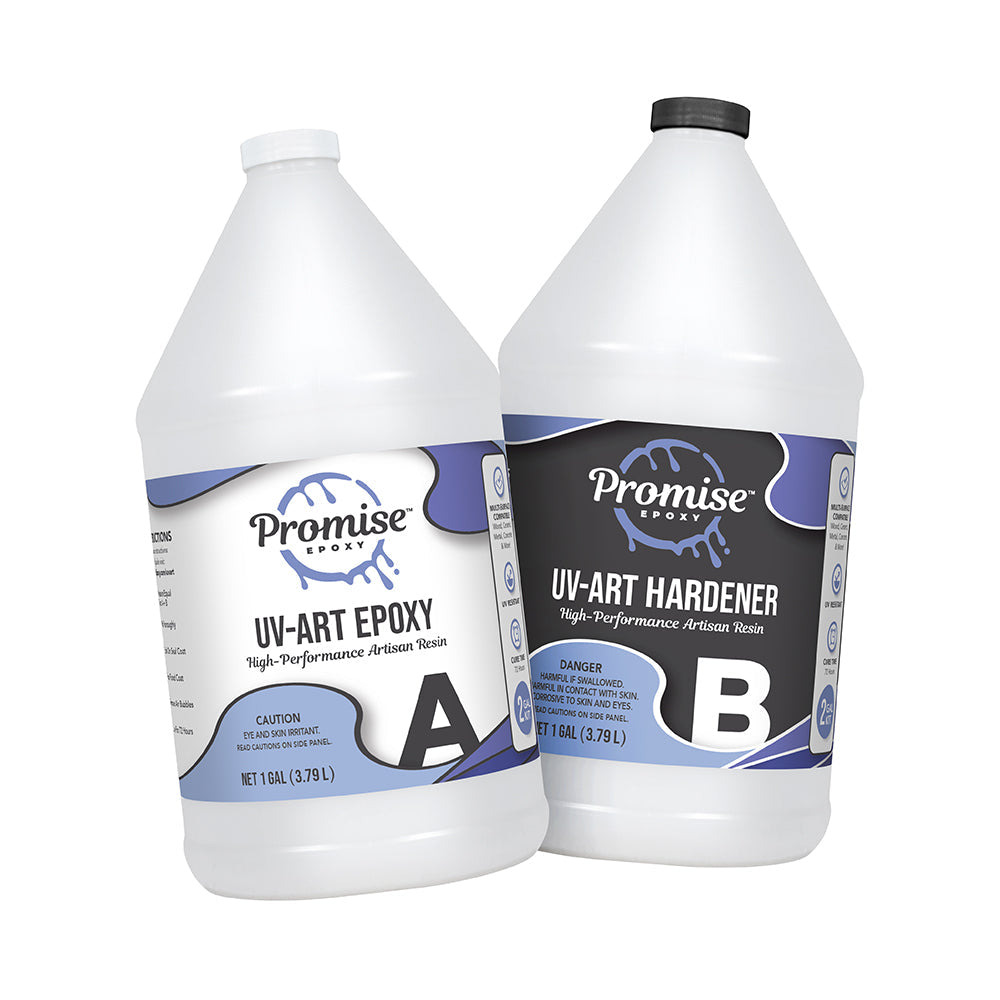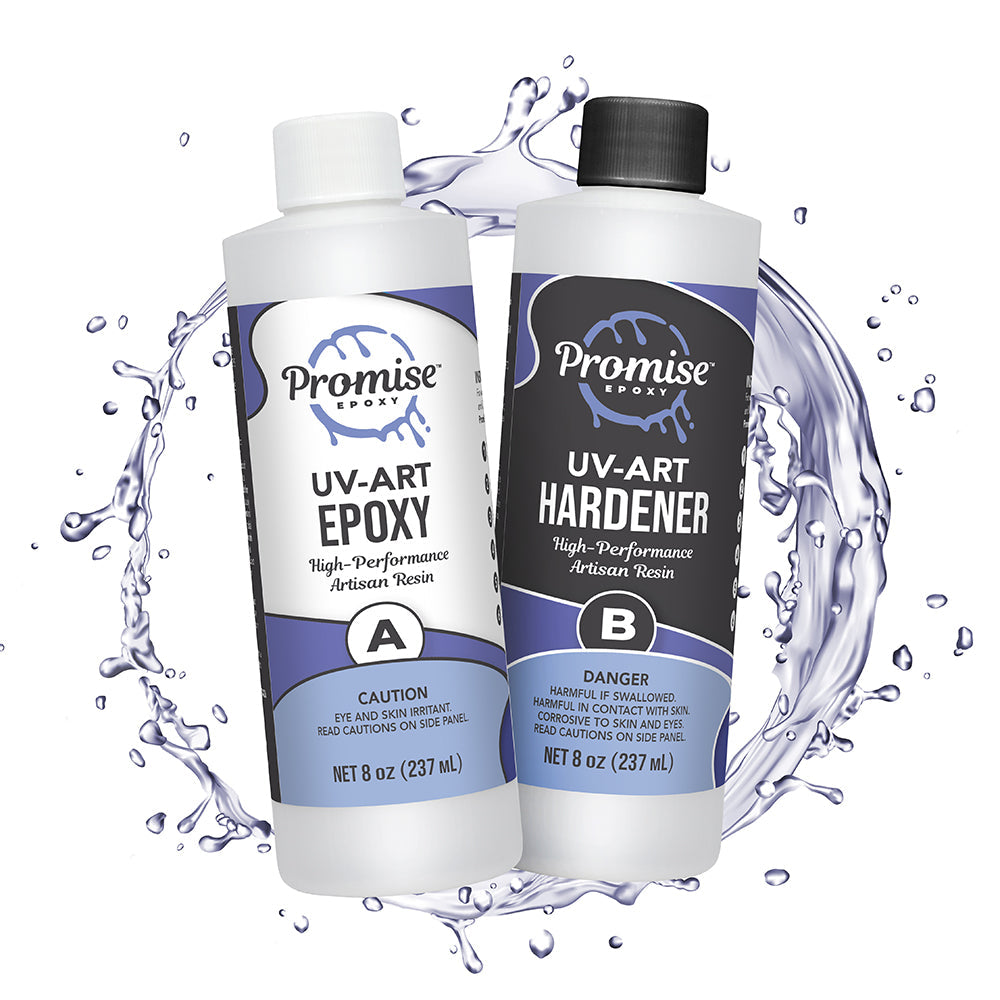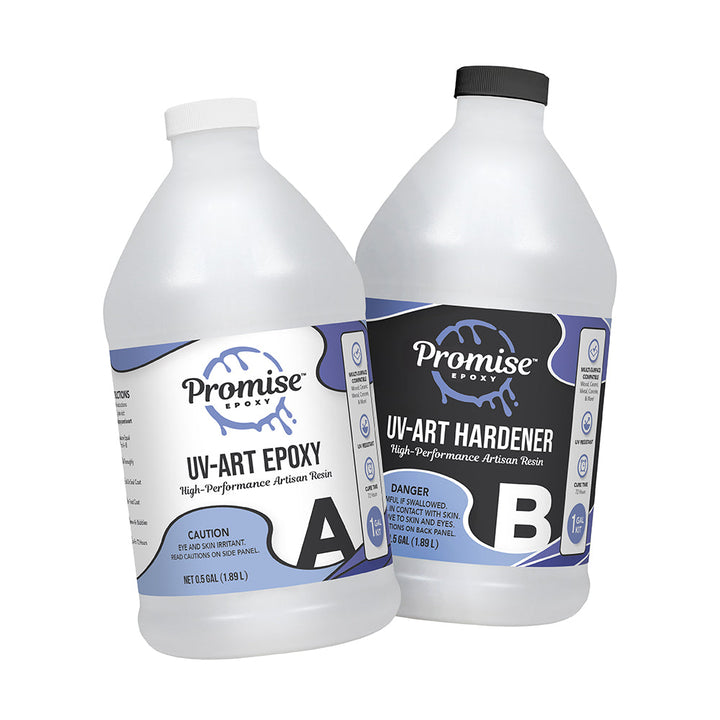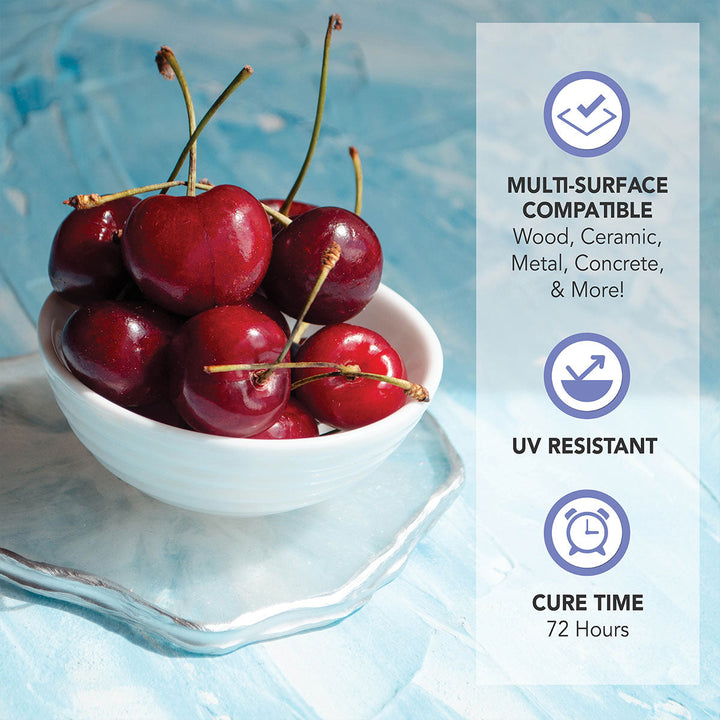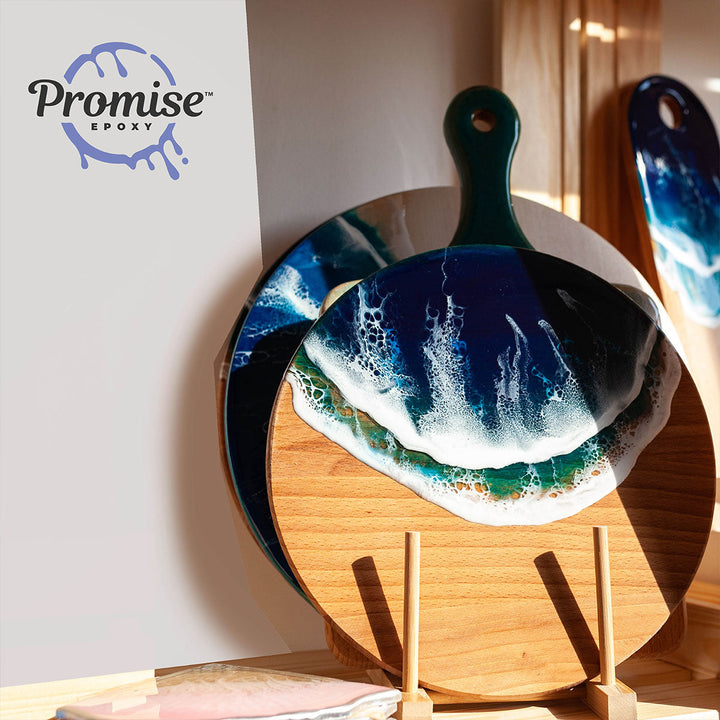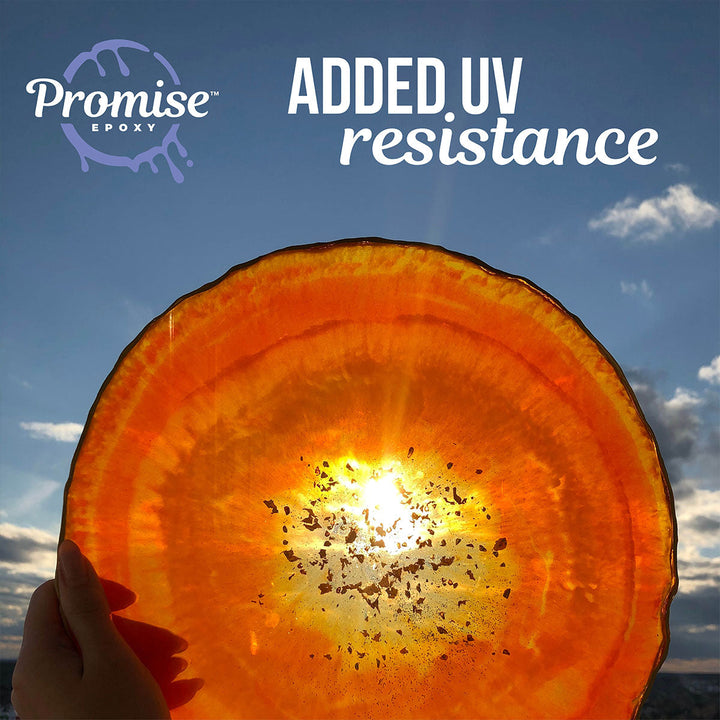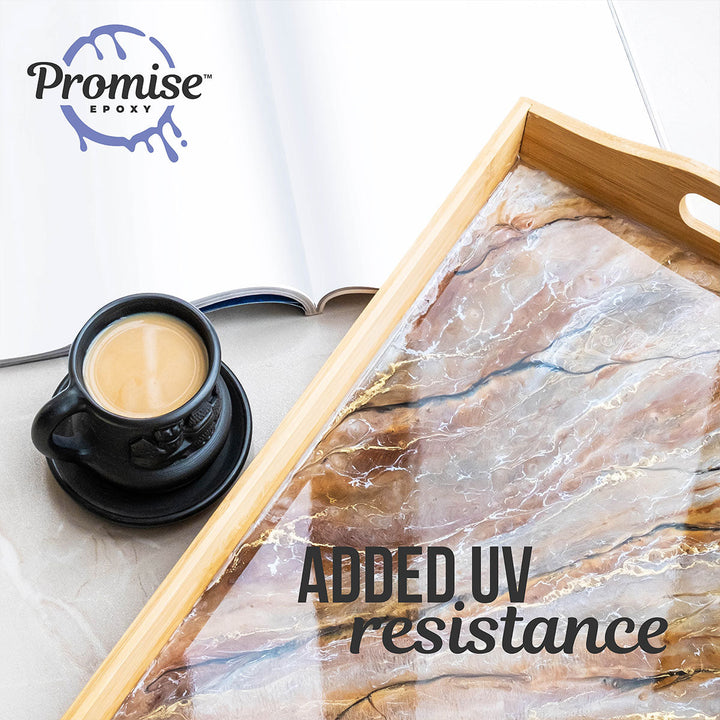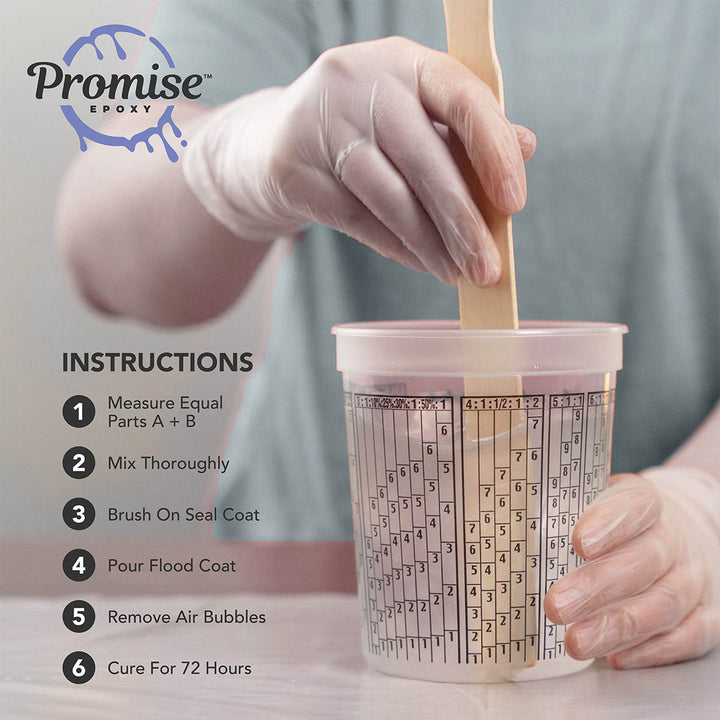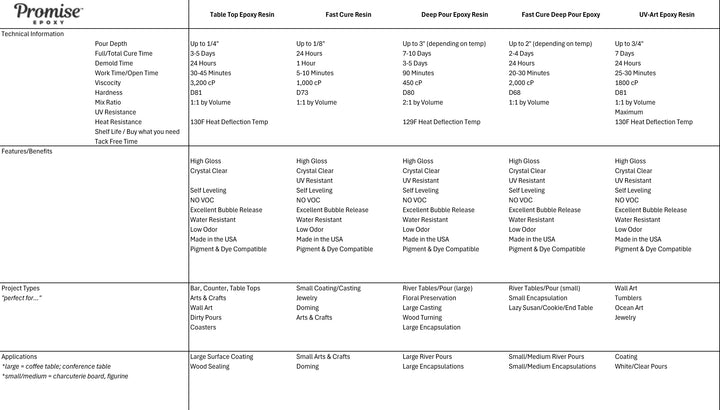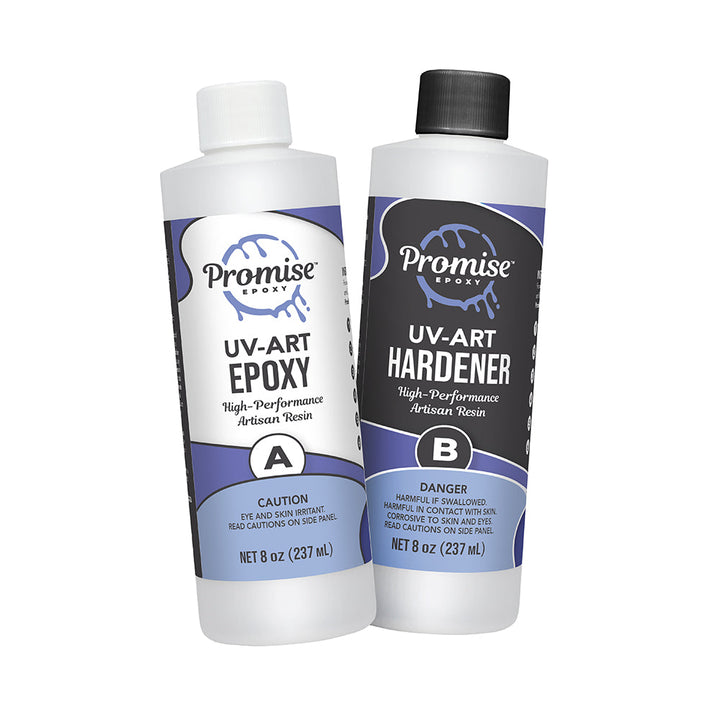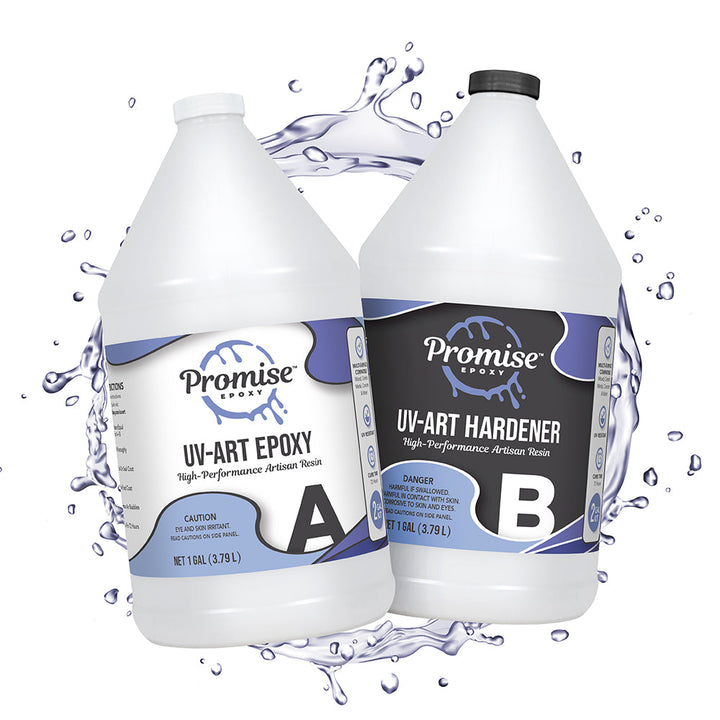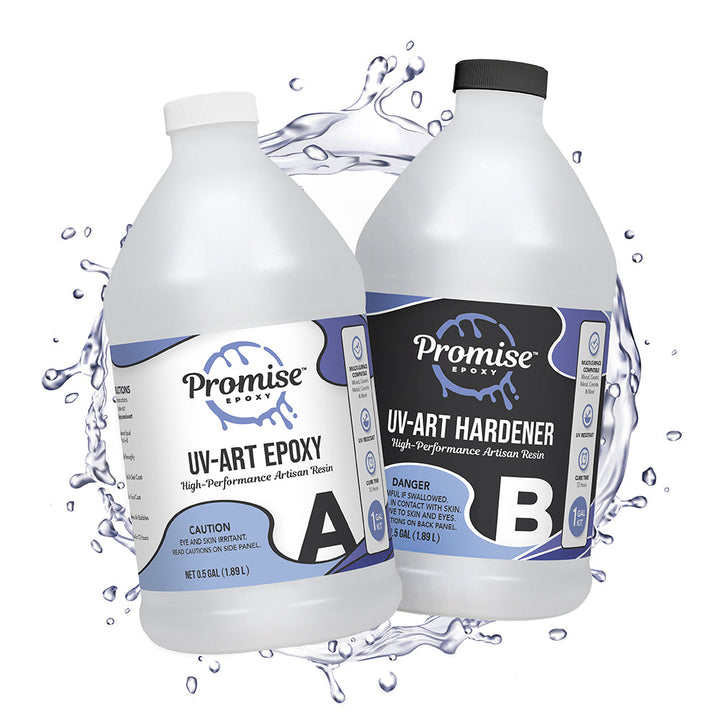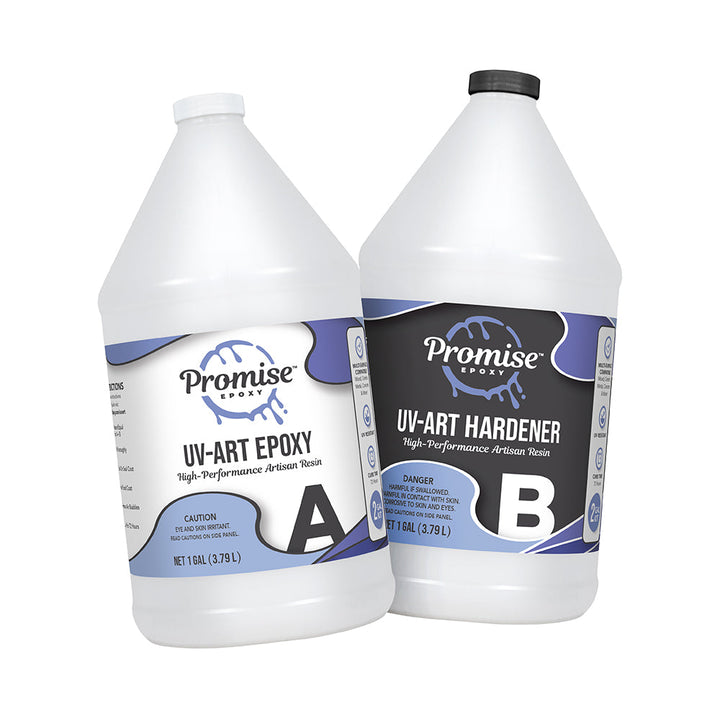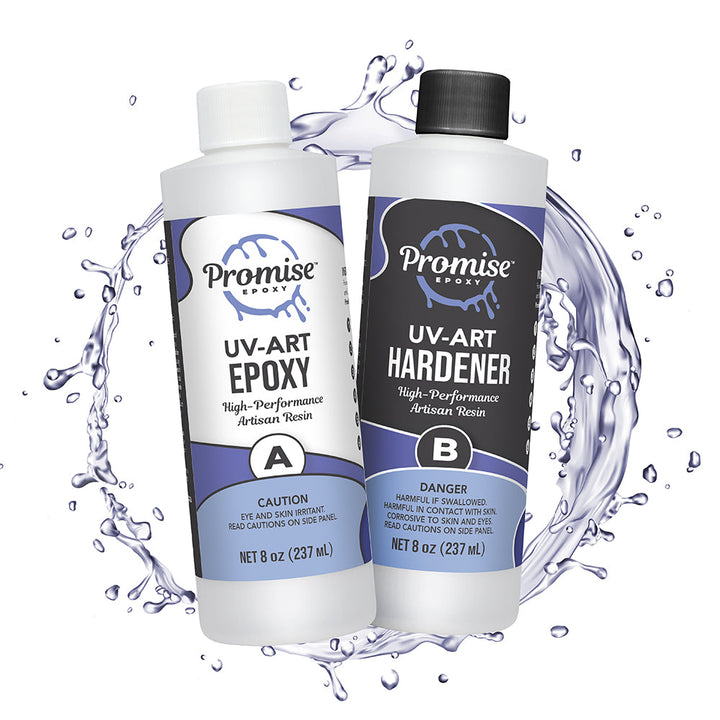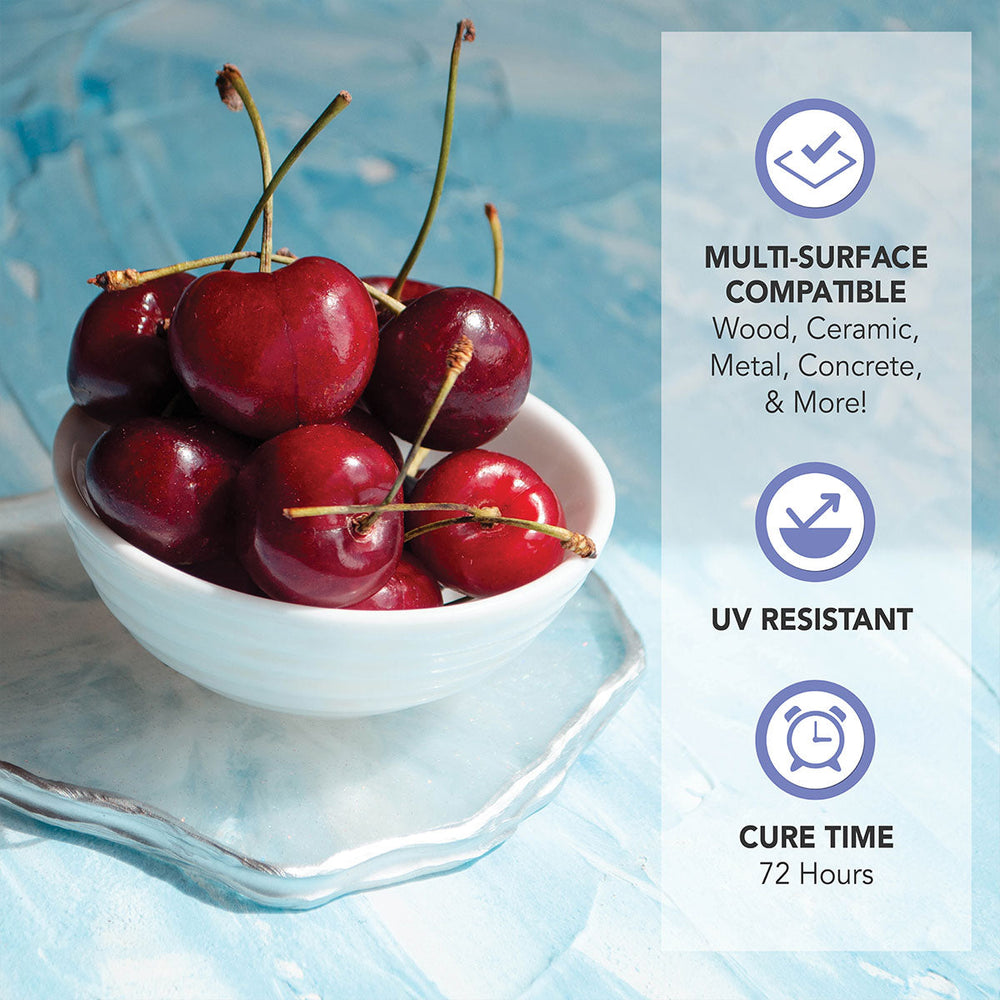Shield your works of art from damaging UV rays with Promise’s UV-Art Epoxy Resin. Designed for the purposes of resisting yellowing from the sun, UV-Art’s self-leveling formula also helps protect your masterpieces from impact, corrosion, and water damage. Lean on Promise products to leave home décor projects and artwork with a gorgeous glossy shine without sacrificing durable protection.
Key Features:
1:1 mixing ratio
Industry-leading UV resistance
Resists moisture, corrosion, and wear and tear
Compatible with pigments and dyes
Promise UV-Art Epoxy Resin is designed to provide a crystal-clear high gloss shine, a protective coating, and long-lasting UV resistance. It’s ideal for creating, sealing, and coating artwork, wood, photography, wall hangings, coasters, and more. Adorn your home with art of your own creation and trust that it’s safeguard with Promise Pro Art.
UV-Art is also formulated to flow on a variety of different surfaces including wood, canvas, metal, plastics, glass, and more.
Your ideas. our support.
At Promise Epoxy, we're not just committed to delivering quality products; we're dedicated to fostering a community of creativity and collaboration.
We believe in inclusivity and the power of shared ideas. Whether you're embarking on an exciting project and need some guidance on the best epoxy products to use, or you're looking to expand your small business or personal brand through a partnership with us, we're all ears! Your projects, dreams, and goals matter to us. And if you have any questions about your order, shipping details, or anything else, our friendly team is here to provide the support you need.
Drop us a message – we're excited to hear from you and be a part of your creative journey!
✉️ info@promiseepoxy.com
📞 (888) 792-3579
Shield your works of art from damaging UV rays with Promise’s UV-Art Epoxy Resin. Designed for the purposes of resisting yellowing from the sun, UV-Art’s self-leveling formula also helps protect your masterpieces from impact, corrosion, and water damage. Lean on Promise products to leave home décor projects and artwork with a gorgeous glossy shine without sacrificing durable protection.
1:1 Mixing Ratio: The straightforward 1:1 mixing ratio and simple application process make this epoxy resin perfect for beginners and experienced DIYers alike. The curing process for our UV-Art epoxy is 72 hours. Our UV-Art Epoxy Resin ensures the most accurate and easy-to-understand mixing process, making it perfect for beginners and experts alike.
Water, Blush, and Impact Resistant: Protect your art and home décor projects from moisture damage thanks to the water-resistant properties of our epoxy resin. This epoxy resin is designed to withstand everyday wear and tear, ensuring your projects remain in pristine condition.
Self-Leveling: Ditch the frustration of inconsistent pours with our easy-to-use, self-leveling epoxy resin for a smooth surface on bar tops, tables, and tons of other projects. Achieve a professional, high-gloss finish with ease as the resin self-levels, resulting in a smooth surface.
High Gloss Finish: Our UV-Art epoxy ensures a crystal-clear finish, allowing your creative vision to shine through. Add a touch of elegance to your projects with our epoxy resin's high-gloss finish.
Food Safe per FDA 300: Our epoxy resin is safe to use on surfaces that come into contact with food, making it perfect for table tops and other kitchen projects.
Improved Surface Appearance: Reduce imperfections and achieve a flawless finish with the help of our epoxy resin's advanced formula. Unleash your creativity on a variety of surfaces, including wood, concrete, metal, and more to get that crystal clear finish.
Eliminates Craters, Crawling, and Fish Eyes: No more worrying about unsightly flaws in your projects thanks to our epoxy resin's ability to eliminate common issues. One important note on this feature; epoxy can NOT be poured over oil based paints and stain. Oil-based products and epoxy do NOT mix.
Compatible with Pigments & Dyes: Get creative with your color choices by mixing this versatile epoxy resin with mica powder, pigments, and dyes. Options are endless in terms of color, glitter & sparkle.
1. Measure equal parts A+B
2. Mix thoroughly
3. Brush on seal coat
4. Pour flood coat
5. Remove air bubbles
6. Cure for 72 hours
UV-Art Epoxy Resin Description
Promise’s UV-Art Epoxy Resin is specially formulated for artisans and crafters. Designed for quicker mixing and longer working times; UV-Art protects delicate artwork with a crystal-clear hard-shell finish. Versatile UV-Art may be used to create, seal and protect a wide variety of projects including drawings, paintings, photography, woodworking, and more with a durable industry-leading UV-resistant coating that resists moisture, corrosion, and handling wear and tear.
Epoxy Resin Advisory Notes:
We strongly recommend that All of these instructions are thoroughly read BEFORE working with epoxy resin.
*This product is not intended to be used with (or over) any type of oil-based products.
*This product is not intended for outdoor use.
*All epoxy has natural variations in color/tint, which may be accented by the color of the surface to which the epoxy is applied. White surfaces, for instance, are always the most challenging in terms of highlighting epoxy hue variations.
1) Before you begin!
Surface Coverage – We offer an epoxy resin coverage calculator to help determine how much epoxy you will need based upon the square footage of the surface you will be working with.
Working Conditions/Temperature – Optimal product working temperature is 75°F–85°F. The product must be stored, mixed, applied, and cured for 72 hours at 75°F–85°F. THIS IS A REQUIREMENT to achieve desired results. If the product has been exposed to cold temperatures; acclimate by placing jugs in a warm water bath. Climate-controlled conditions are required to properly work with epoxy to control both temperature and humidity levels—which affect both working time and proper curing.
Safety – This product has no Volatile Organic Compounds (VOCs); however, we recommend working with epoxy resin in a well-ventilated area. We also recommend protective eyewear and gloves when working with the product. NOTE: Some people may be more sensitive to epoxy than others – and may wish to wear a ventilator when using the product. For skin contact, wash with soap and warm water. If the epoxy comes in contact with your eyes, do not rub them. Repeatedly flush with water for 15 minutes. If irritation persists, seek medical attention immediately. Please contact us for a Materials Safety Data Sheet. (MSDS)
Surface Preparation – The project surface should be free of any dirt, dust, oils, or grease. Denatured alcohol or acetone can be used to clean the surface with a lint-free rag. Your surface should be level so the epoxy can self-level. The room you are working in should be clean, dry, dust and insect-free. Settling dust can cause imperfections on the surface of the epoxy as it is curing.
2) Measuring and Mixing – Tools & Tips
UV-Art’s two-part epoxy resin formula was created specifically for intricate art and craft projects. The mixing ratio is a simple-to-use 1-to-1 volume of resin to hardener and is designed to be self-leveling for easy application. UV-Art works with a variety of substrates such as wood, canvas, metal, and plastics, and mixes well with pigments like powdered and liquid tints and dyes for enhancing works of art.
Measuring – It is imperative that the product is measured as accurately as possible and mixed thoroughly. Measure 1 part RESIN to 1 part HARDENER by liquid volume (not weight). Do NOT vary this ratio.
NOTE: We do not recommend mixing a combined total of more than 1 gallon at a time.
Mixing – Add Hardener then Resin to a mixing container with about 30% greater capacity than the amount of product you are mixing.
The goal of mixing is a thorough combination of the two parts. (It helps some people to think of a cake batter mix.) In order to obtain a uniform consistency after mixing, scraping the sides & bottom of the container during mixing is required.
Mix with a flat bottom stir stick or silicon spatula being sure to scrape the sides and bottom of the container multiple times as you mix. Do not beat or whip the epoxy. A folding motion combined with stirring and scraping the mixing vessel sides will allow you to thoroughly combine the two parts. Mix time varies by the volume of product being mixed. UV-Art epoxy quantities of 64–128 ounces typically require 5–8 minutes.
Do not mix any longer than 8-10 minutes. Overmixing the epoxy will cause it to cure quickly in the mixing cup. The product will also get hot and possibly smoke. If you are mixing several batches of epoxy, be sure to use a new, clean container every time.
Pro Tip – If you are new to using epoxy, we recommend starting your mixing process with small batches until you get the hang of it. Epoxy is a time-sensitive product and needs to be mixed and poured before the epoxy begins to cure. Epoxy cures when the two components are mixed in the correct ratio. The process is an exothermic reaction (gives off heat). We do not advise mixing more than 1 gallon of combined product at a time. If the product is mixed and applied per these directions premature curing can be avoided.
Factors that may cause epoxy resin premature curing are:
*Over-vigorous mixing – mix by hand (don’t whip)
*Mixing for too many minutes
*Allowing epoxy to sit in the mixing vessel too long after mixing
*Pouring too deep a layer – the epoxy is designed for 1/8″ thick flood coats with a maximum of 1/4″ depth
*Why is this happening? As soon as the two parts of epoxy and resin are combined, the exothermic reaction that leads to eventual curing, begins. The process of pouring the mixture onto a surface spreads out the epoxy, so it may undergo its reaction as expected. When the mixture is confined—in a mixing vessel—the reaction is intensified and will occur in a much faster and concentrated manner. This leads to excessive heat and possibly smoking. This also occurs during a deep pour.
3) Application & Curing
Seal Coat - A seal coat is a small batch of epoxy that is typically brushed on in a thin layer to seal a porous surface (hardwood, barn wood, knotty wood, etc.). The seal coat minimizes the release of air (bubbles) from the surface into the flood (or finish) coat. (see below). Promise Epoxy Resin is used for both seal coats and flood coats.
NOTES:
Do Not use the product over any oil-based or unknown coatings
Aged and kiln-dried porous woods may need multiple seal coats – it is not uncommon for as many as 3 seal coats to be used on these surfaces
You may skip the seal coat when pouring the epoxy on a non-porous surface
To apply a seal coat, start on one end of the artwork and pour the resin the full length of the surface, zigzagging as you go. Then use a rubber squeegee, spatula, or a foam brush to move the resin around – covering the entire surface in an even coat. As epoxy cures rather rapidly in the container, it is necessary to paint the seal coat on quickly; or mix up small amounts as you apply to avoid curing in the container while you are working.
Air Bubbles – Once the entire surface has been covered with a seal coat, the process of releasing/removing air bubbles may begin. The best tool for removing bubbles is a small propane torch. (A heat gun may also be used but takes a bit more practice to manipulate as easily and effectively as a torch.) Hold the flame approximately 6–10 inches away from the tabletop and quickly sweep across the entire surface using a waving motion. The heat from the torch/gun will allow for the release of the air bubbles.
NOTE: it is best to intermittently check the surface for bubbles for up to an hour using a torch (or heat gun) as needed.
Once the entire surface is sealed, wait 4–6 hours before applying the flood coat. If the seal is allowed to cure, just lightly sand the surface (320-grit) and wipe clean with a drop of denatured alcohol or acetone before flooding—to ensure adhesion of the next coat.
The Flood/Finish Coat - to apply the flood coat, start on one end and pour the resin the entire length of the surface, zigzagging as you go. After you are finished pouring your mixture, set the container down. DO NOT SCRAPE ANYTHING OUT OF THE MIXING BUCKET. Because you are pouring about three times the amount of product you did with the seal coat, the material will immediately start to flow out. However, you may still want to use a rubber squeegee or foam brush to help guide the material around. A true flood coat will require minimal manipulation.
The product is designed for 1/8″ thick pours but people often pour up to 1/4″ thick at a time. After 4 hours you can pour another layer directly onto the previous layer. If it has been more than 10 hours the previous layer should be lightly sanded (200–300 grit) and wiped clean with a drop of denatured alcohol or acetone before pouring your next layer.
Edges and Drips – The flood coat can be allowed to run over the edges of artwork which will create a coating on the vertical edges. These vertical edge coatings will not be as thick as the top surface coating; so, manipulation with a brush to keep the layer even is suggested. Drips will form underneath the edge, which can be sanded off once the epoxy has cured. Or, if you catch the epoxy when still soft during the curing process, drips may be cut or scraped off.
Air Bubbles – Once the entire surface has been covered with a flood coat, the process of releasing/removing air bubbles may begin. The best tool for removing bubbles is a small propane torch. (A heat gun may also be used but takes a bit more practice to manipulate as easily and effectively as a torch.) Hold the flame approximately 6–10 inches away from the artwork and quickly sweep across the entire surface using a waving motion. The heat from the torch/gun will allow for the release of the air bubbles.
NOTE: it is best to intermittently check the surface for bubbles for up to an hour using a torch (or heat gun) as needed.
Curing – After applying the final coat, the epoxy resin surface should be kept in a clean, dust-free environment at a minimum of 75°F–80°F for 72 hours.
Heat Resistance – The heat resistance once fully cured is 120°F/57°C. The use of coasters and placemats is recommended to protect tabletop surfaces and also reduce heat transfer.
How do we package our epoxy?
Our resins and hardeners are packaged in plastic jugs up to one gallon in size and with a sealed top. Multiple gallon kits are still shipped in gallon increments. We take great pride in our packing methods which are followed for every box we ship. This means your shipment virtually always arrives intact and damage free.
~
Shipping & Handling Times?
Shipping time is dependent on what item was purchased, how heavy the order is, and how far away you live from our shipping facilities.
We are proud that we can offer our customers a free shipping option that saves them money. Typically, this free shipping method takes about 2–3 business days, but can sometimes be longer by up to 5 business days. Larger orders that require freight can take up to 14 business days.
If you have any questions regarding shipping or handling, please feel free to contact us.
info@promiseepoxy.com
1-833-769-9776
Customer Service Hours of Operation
Monday–Friday
9 AM–5 PM Eastern Time
Holidays will affect handling time. Promise Epoxy recognizes all holidays that our shipping carriers recognize. For more information, please check the shipping carrier’s website for the holiday schedule.
~
What if my epoxy freezes during shipment?
Our testing has shown that epoxy freezing for a short period of time is not harmful to the product and will properly cure. You must bring the product back to its natural state. We strongly suggest not storing the epoxy anywhere which could result in freezing for more than a few days.
Returns Policy
You may return most new, unopened items within 30 days of delivery for a full refund. We'll also pay the return shipping costs if the return is a result of our error (you received an incorrect or defective item, etc.).
You should expect to receive your refund within 4 weeks of giving your package to the return shipper; however, in many cases, you will receive a refund more quickly. This period includes the transit time for us to receive your return from the shipper (5–10 business days), the time it takes us to process your return once we receive it (3–5 business days), and the time it takes your bank to process our refund request (5–10 business days).
If you need to return an item, simply contact us at info@promiseepoxy.com so we can process a return request and send you a return label.
International Orders and Returns
There will be no returns accepted for international orders. Additionally, because a shipping forwarder is used for international orders, shipping times may vary and change, as the transit time is longer and is shipping from inventory located in the United States. Shipping/delivery time is never guaranteed on International orders.*
*Please also consider transit time from our warehouse to our shipping forwarder (2–3 business days).
Same-day shipping only applies to orders placed in the United States.
Are the packages insured?
By default, all international shipments are insured. We insure for loss of delivery, damages during transit, and shortfalls (such as if some items are missing). We will need some proof (usually a photo) from the consignee to file a claim. We settle all claims 45 days after the shipment was dispatched. We have to wait for 30 days to make sure that the delivery is not misrouted.
Handling Times
Orders placed before 1pm EST will typically ship same day.
Our standard lead times are two business days for ground packages and two weeks for freight shipments. We know you’re eager to get your order, so if there’s an opportunity to ship your package sooner, we’ll make it happen. While we aim to meet or exceed these timelines, please keep in mind that factors such as order size and shipping destination may affect delivery times. If you have any questions about your order or need assistance, our support team is always here to help.
Customer Service Hours of Operation
Monday-Friday
8 AM – 8 PM EST
Holidays will affect handling time. Promise Epoxy recognizes all holidays that our shipping carriers recognize. For more information, please check the shipping carrier website for the holiday schedule.
Shipping Times
Shipping time is dependent on what item was purchased, how heavy the order is, and how far away you live from our shipping facilities.
If you choose any of our free shipping methods, then we will ship the order out as economically as possible based on these US carriers: FedEx. We do not allow our customers to specify which carrier we use. If you desire, you can select from multiple shipping methods at the checkout section. Shipping fees will be charged accordingly.
We are proud that we can offer our customers a free shipping option that saves them money. Typically, this free shipping method takes about 2–3 business days, but can sometimes be longer by up to 5 business days.
If you have any questions regarding shipping or handling, please feel free to contact us.
info@promiseepoxy.com
1-833-769-9776
While casting resin may be used on canvas, photography, or other artwork it is recommended that a protective layer of sealing epoxy resin (such as UV-Art) first be applied and allowed to cure to protect the underlying piece.
Yes, Promise UV-Art Epoxy Resin is formulated with a durable industry-leading UV-resistant coating that resists moisture, corrosion, and handling wear and tear. This also helps prevent yellowing over time.
Art resin, by its very design, is meant to be a surface coating for artwork and craft creations—and will self-level to approximately 1/8” in thickness. However, you can make the coating as thick as you like by adding additional 1/8” layers, waiting about 4–5 hours between layers for some curing to occur. This method may also be used for molds and casts. Additionally, layers may be added to the fully cured resin, if the surface is lightly sanded with 200–320 fine grit sandpaper first to help ensure adhesion.
Promise UV-Art Resin is specially formulated for quicker mixing and longer working times. The polymer may be thoroughly mixed in small amounts in as little as three minutes and features working times of 30–45 minutes depending upon factors such as ambient temperature and relative humidity (see above). UV-Art sets to a hard cure in 24 hours—with a full cure occurring in 72 hours.
The heat resistance once fully cured is 135°F/57°C. The use of coasters and placemats is recommended to protect tabletop surfaces and also reduce heat transfer.
Unused and unmixed epoxy resins are not waste and may be saved for future projects—tightly sealed in their original containers at room temperature for six months. Reusable tools may be cleaned as outlined above, while disposable tools may be safely disposed of once the resin has fully cured. The fully cured epoxy resin may be disposed of as non-hazardous waste in most municipalities—check your local waste management requirements.
Whether you are bonding, fairing or applying fabrics, the success of the application depends not only on the strength of the epoxy but also on how well the epoxy adheres to the surface to which it is being applied. Three critical steps for surface preparation of any secondary bonding operation.
Surface Preparation: Clean – Dry – Sand
1. Clean – Bonding surfaces must be free of grease, oil, wax, mold release or any contaminants. Use lacquer thinner, acetone or other appropriate solvents to clean surface. Then wipe the surface with paper towels before the solvent dries. Follow all safety precautions when working with solvents.
2. Dry – All bonding surfaces must be as dry as possible for good adhesion. To accelerate drying use a hot air gun, hair dryer or heat lamp. Use fans to move the air if working in confined or enclosed spaces. Watch out for condensation when working outdoors or whenever the temperature of the work environment changes.
3. Sanded – Sand smooth non-porous surfaces with 80-grit aluminum oxide paper will provide a good texture for the epoxy to “key” into. Remember to remove any flaking, chalking, blistering, or old coating before sanding. Remove all dust after sanding.
1) Keep it cool – keep your materials cool and out of the sun, work in the shade whenever possible, and try to work when it’s cooler.
2) Test mix a small amount – you’ll get a good feel for the amount of working time/pot life you have if you test mix a small batch first.
3) Substrate temps matter too – the temperature of the material to which you’re applying epoxy matters too, as it will heat up the polymer.
4) Your temp matters too! Keep yourself as cool as possible and hydrated when working in the summer heat and take breaks as needed.
5) And for those of you addressing boating or other nautical applications using marine grade epoxy resin, use a slow hardener for warm weather as it cures best at 80°F.
Epoxy resin functions best in cooler temperatures of about 75°F (22 °C). So if you can work in a climate-controlled environment, you’ll get better results. Significant increases in temperature of 15°F–20°F (10°C) can easily halve the working and application times of the polymer. Another quick tip when working in sunlight, be sure to mix your resin in plastic containers and not metal. Plastic will help keep the materials cooler.
If your product has a cloudy finish, you can use a multi-purpose clear gloss finish/sealer. Start by placing your project in a cardboard box in a well-ventilated area. The working conditions should be less than 75% humidity.
Alternatively, you can do a seal/flood pour on top and brush it on with a grey foam brush. Make sure to let it dry for at least 24 hours. This will add a clear glass-like finish.
Cold temperatures can affect epoxy resin in several different ways:
Curing time: More frigid temperatures slow down the curing time for the epoxy resin. This may be beneficial if you are looking for a longer working time, but it also means that your project will take an extended amount of time to complete.
Product viscosity: In cooler temperatures, epoxy does not flow as smoothly. You may notice that the product seems much thicker than usual to pour and mix. If your product or surface is too cold, a self-leveling epoxy may not level properly and leave you with imperfections like fisheyes.
Humidity Problems: When you’re working in colder temperatures, increased humidity in the atmosphere may also affect your project. You may get moisture settling on the uncured epoxy which can lead to blushing, surface defects, or reduced shine/gloss.
Don’t worry if your epoxy has traveled through cold areas to get to you. Be sure to acclimate your epoxy back to the proper temperature (75°F) before use.
Once the entire surface is sealed, wait 4–6 hours to pour the flood coat. Do not exceed 10 hours or you run the risk of the flood coat not blending into the seal coat flawlessly.
You can add multiple flood pours. Each flood coat self-levels at approximately 1/8” thick. If depths thicker than 1/8” are desired multiple coats are necessary. You must wait at least 4–10 hours between flood coats. The epoxy will still be tacky so the next pour will stick to it.
If you wait more than 10 hours, you must scuff up the surface lightly with 222–300 grit sandpaper then wipe it clean with denatured alcohol or acetone before applying another coat. Just minor scuffing of the surface is all that you need to do so the next flood coat has some grip to stick to.
The best way to apply the flood coat is to start on one end and pour the resin the entire length of the surface, zigzagging as you go. After you are finished pouring, set the container down. Do NOT try to scrape anything else out of the bucket. Because you are pouring about three times the amount of product you did with the seal coat, the material will immediately start to flow out. However, you will still want to use a rubber squeegee or foam brush to help guide the material around. The less you use the brush, the better.
As long as the product is still mixable (i.e. not cured), it is still viable for use. The mixing process should thin out the discoloration, making viable epoxy resin for your use. Please also keep in mind that when mixed with pigments tints or dyes no yellowing will be noticed. All epoxies with time do yellow. However, when used it will cure just as it did the first time you used it.
First let’s take note as to why this happened.
Reason -1- under-mixed – Mixing is a crucial part of the project. Mixing of the product should be done by hand with a clean stir stick. The more product you are mixing, the longer it will take to achieve a complete mixture. One gallon of the mixture takes approx. 4–5 minutes of mixing. Two gallons of mixture take approx. 6–7 minutes of mixing. Timing this with a watch is a good idea. While mixing make sure to scrape the sides and the bottom of the container to avoid under-cured epoxy. Be sure to push thoroughly down with the stir stick or, you can end up with areas that are hard/dry with other areas that are sticky or tacky that will not harden.
Reason -2- inaccurately measured – If you have measured and mixed your resin correctly, this problem will not occur. You must follow the strict 1-to-1 ratio by volume. Do not guess or eyeball these measurements. Just dumping the product from their original containers is not a proper measurement. It must be measured with reasonably precise accuracy using a graduated tub.
Don’t worry – you can fix this!
Epoxy that remains sticky after the curing time will stay sticky unless the following measures are taken to repair the situation.
1. Scrape off the wet epoxy
You will have to start by scraping off all of the wet epoxy.
Don’t worry – your project or art underneath will not be disturbed. Be sure all the liquid epoxy is removed before you pour your coat of fresh Epoxy on top. If you do not scrape off the wet epoxy, this could result in leaking under the new Epoxy coat. Wipe with denatured alcohol.
2. Sand your project (finish it off with 222–230 fine sand grit paper)
You’ll want to sand the entire piece, next. Be sure to include the cured patch, if you needed to patch any holes or gaps. After sanding, wipe off any dust from the entire surface. (wipe it off with denatured alcohol or acetone)
The object is to create a layer that the new epoxy can adhere properly to.
Don’t be worried if it looks like a mess at this point—when you pour the second coat, it will look as good as new!
3. Pour The Second Coat (pour 1/8″new flood coat)
Be sure that your first coat is 100% cured and go ahead and pour your second layer.
We recommend using our epoxy within 6 months of purchase.
Store your epoxy resin and hardener at room temperature and keep it closed and in its original container to prevent contamination. With proper storage, resin and hardeners should remain usable for up to 6 months after opening. After lengthy storage, mix a small test batch to assure proper curing, before using.
Hardeners may darken with time, but physical properties are not affected by color. If clear finishing, be aware of a possible color change if very old and new hardeners are used on the same project.
To request a SDS, please email us at jeff@eyecandycustomz.com



